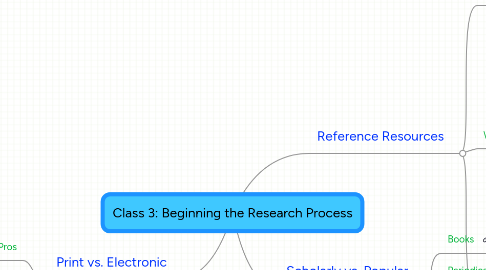
1. Print vs. Electronic
1.1. Pros
1.1.1. easy to search through electronic versions
1.1.2. easy access for users - no need to come to library
1.1.3. can save administrative and storage costs
1.1.4. publishers save on printing, binding, warehousing, shipping, handling costs
1.2. Cons
1.2.1. often requires additional software to read
1.2.2. reading from screen sometimes difficult for many
1.2.3. pushes cost of printing to user
1.2.4. not as portable to users
2. Reference Resources
2.1. Definition
2.1.1. Book designed to be consulted for definite items of information rather than to be read cover to cover
2.2. What are they?
2.2.1. Characteristics
2.2.1.1. Collection of information
2.2.1.2. Intended to be found quickly
2.2.1.3. Referred to for specific pieces of information
2.2.1.4. Emphasis on fact
2.2.1.5. Written in informative style
2.2.2. Uses
2.2.2.1. find statistics, dates, addresses, formulas, other factual information
2.2.2.2. get broad overview and background information
2.2.2.3. gain clear understanding of a topic
2.2.2.4. get definition of unfamiliar term
2.2.2.5. locate additional resources on topic
2.2.2.6. obtain summary of events surrounding topic
2.2.2.7. discover how to complete a task, solve a problem, answer a question
2.3. Examples
2.3.1. Types
2.3.1.1. Those that contain needed information
2.3.1.1.1. Dictionaries
2.3.1.1.2. Encyclopedias
2.3.1.1.3. Handbooks/Manuals/Guides
2.3.1.1.4. Thesauri
2.3.1.1.5. Almanacs/Yearbooks
2.3.1.1.6. Statistical sources
2.3.1.1.7. Directories
2.3.1.1.8. Biographical sources
2.3.1.1.9. Geographical sources
2.3.1.2. Those that tell reader where the information can be found
2.3.1.2.1. Bibliographies
2.3.1.2.2. Indexes
